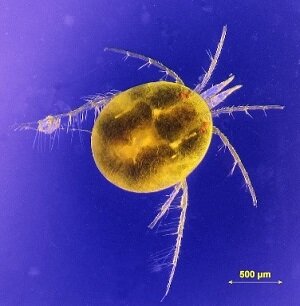Life Underwater Series: Life of the Aquatic Mite
Life of the Aquatic Mite: the free riders
The aquatic mite is a fascinating benthic macroinvertebrate that will undergo incomplete metamorphosis involving the following phases: the egg, the nymphal stage, and the adult stage. Today we will explore: What happens after the aquatic mite leaves the safety and familiarity of the water? And how does the aquatic mite transform into its adult form? To explore these questions, we’ll start at the very beginning-- when the aquatic mite eggs are first laid.
When mating the male aquatic mite will grasp the female and transfer a sperm packet to the female, fertilizing up to 400 eggs, which she will then attach to submerged vegetation.
After they have hatched, the aquatic mite larvae will seek a food source either near the water surface or along the bottom substrate of the water body. Throughout a period of a couple of days to several months the larvae will parasitize a host that may include damselflies, dragonflies or other types of flies and feed on it until it reaches maturity. Notice the red coloured mites on the underside of the dragonfly’s thorax on the image to the left.
Now ready to transform into a nymph called a deutonymph, it will seek aquatic insects to parasitize as well as crustaceans and other mites, growing in size as it feeds. During this stage it does resemble its adult form, however the aquatic mite is not reproductively mature. When ready, the deutonymph becomes a tritonymph during which it transforms into the sexually mature adult form.
As an adult, the aquatic mite is ready to mate and begin the cycle all over again. During this adult phase the mite will consume similar prey and may parasitize a large range of insect groups, which allows it to act as a regulatory on the population numbers of other benthic macroinvertebrates in the ecosystem.
Fun Fact: Aquatic mites can survive at very low oxygen concentrations because they do not need gills and can absorb oxygen from water through their bodily surface.
Fun Fact: Aquatic mites will establish colonies in fresh water bodies and they do this by parasitizing their host during their larval or pupal phase. Once their host has entered the adult phase and developed wings the aquatic mites hitch a ride while their hosts remain unaware, travelling to fresh aquatic regions with the aquatic mites.
Interested in learning more about benthic macroinvertebrates and how they can be used to measure the health of rivers and streams? Be sure to follow EcoSpark’s social media to stay updated on our Changing Currents program and our other citizen science and environmental education programs.
References
Ashely, J. (2018). Montana Wild & Free: Odonata Freeloaders. Retrieved from: http://wildandfreemontana.blogspot.com/2011/08/odonata-freeloaders.html
Matthews, G. (2018). Freshwater Mite (Hydracarina). Retrieved from: http://www.photomacrography.net/forum/viewtopic.php?t=7101
Carina holds a Bachelor of Honors in Environmental Studies and a diploma in Ecosystem Technology, both of which developed her interest in using geographic information systems to communicate about complex issues, such as climate change. In her role as Lead Environmental Educator, Carina designs geospatial education tools for EcoSpark’s citizen science programs. When outdoors in the field, you will often find her streamside identifying aquatic critters, communicating her enthusiasm for the outdoors, and demonstrating her dedication to stewardship practices with youth and adults throughout the GTA.



